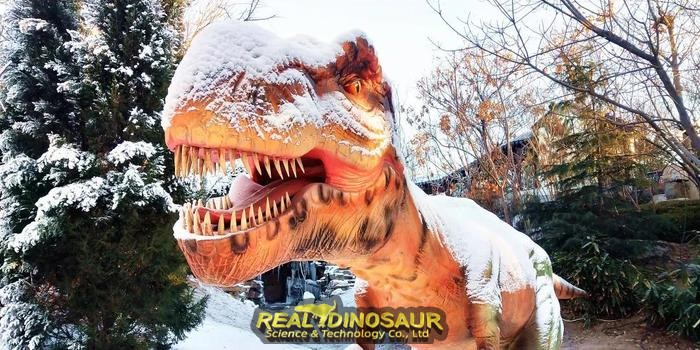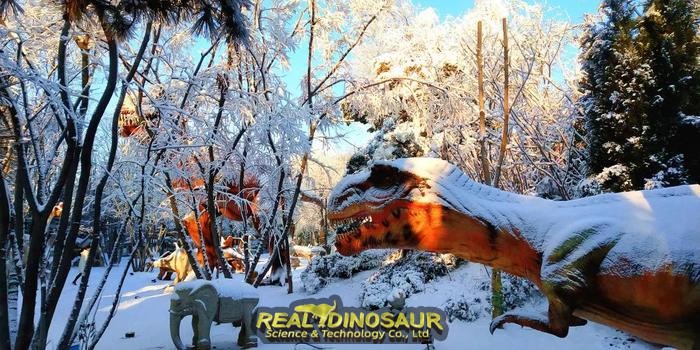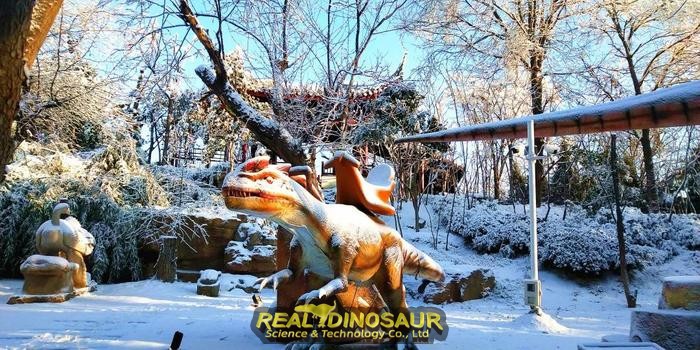News
Maintaining Animatronic Dinosaurs in Extreme Cold Weather
Do you know how to maintain and care for animatronic dinosaurs in low-temperature cold environments? What should be noted?
Today, let’s learn about the methods of caring and maintaining for animatronic dinosaurs together!


This year’s weather is quite unusual, with global winter temperatures generally higher. However, in some areas, the climate remains very cold, especially in countries in the northern hemisphere where temperatures have approached minus 40 degrees Celsius. Pedestrians on the streets are all dressed in thick down jackets. But animatronic dinosaurs don’t have “down jackets” to wear, especially in such cold weather, which poses a significant challenge to the quality of outdoor products. Animatronic dinosaurs, due to long-term exposure outdoors without any shelter (the silicone coating of the dinosaur’s skin may become stiff and prone to cracking due to cold contraction), can greatly impact the lifespan of the simulated dinosaurs. In such conditions, how should simulated dinosaurs be maintained and cared for?
Let me explain why various issues are prone to occur with animatronic dinosaurs in winter. Because winter air is dry and cold, the skin of dinosaurs is usually coated with a thick layer of silicone applied with a sponge to provide good extensibility and waterproof performance. In winter’s low temperatures, these materials can freeze, causing them to become stiff and reducing extensibility. Once powered on without sufficient extensibility, it can lead to tearing and damage to the appearance of the dinosaur, significantly reducing its lifespan. This is the main reason why the skin of animatronic dinosaurs is prone to damage in winter.


Therefore, in winter, it is essential to carry out necessary maintenance for animatronic dinosaurs. Firstly, snow accumulation needs to be cleared, as excessive snow can increase the motor load, leading to various complications such as motor burnout and damage to the transmission structure. Snow clearing must be performed every day before using the dinosaurs. If animatronic dinosaurs are working less or not working at all in winter, and conditions permit, they can be covered with cotton cloth for warmth. Try not to expose them for too long in low-temperature cold weather, as it can easily lead to cracking and damage to the skin. This is particularly evident in animatronic dinosaurs that have been in use for a long time, as the aging of the material over time reduces its lifespan, and in cold winter temperatures, surface cracking is almost inevitable. If the dinosaur’s appearance has already cracked in winter, and it cannot be restored through maintenance, the only solution is to repair and re-make the skin and coloring before the arrival of summer. Otherwise, rainy weather in summer may cause internal water accumulation, damaging the electronics and rendering it inoperable.
Our produced animatronic dinosaurs use aging-resistant nylon mesh fabric that can withstand temperatures from minus 50 degrees Celsius to positive 50 degrees Celsius. The motors use brushed DC motors, which can operate under overload even in icy and snowy weather. In extremely cold and humid areas, it is particularly important to note that after the skin of the dinosaur freezes, it should not be powered on, as this increases the internal motor workload and makes it more prone to tearing the skin. If ice is found on the skin, it must be thoroughly cleaned before operation.
Special attention is needed in the following regions:
Such as northern Russia, northern Canada, northern Europe, Mongolia, etc. In these areas, animatronic dinosaurs and installations must prevent skin freezing. Also, precautions must be taken to prevent dinosaurs from collapsing due to unstable center of gravity after strong winds and freezing. Pay attention to the latest information on local climate changes in weather forecasts, so as to take further preventive measures in advance. To extend the lifespan of dinosaur models, managers should promptly cover them with insulation materials. Secure doors, windows, fences, scaffolding, temporary structures, and other easily moved buildings in the exhibition hall of animatronic dinosaur models.